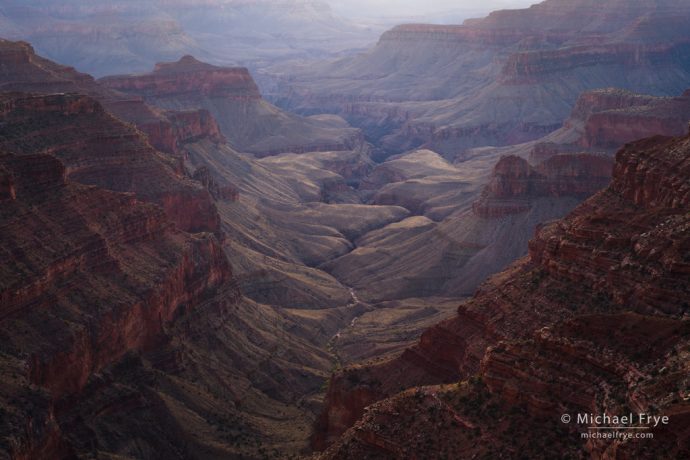In a recent post I described how Claudia and I made a spur-of-the-moment detour to the North Rim of the Grand Canyon. We arrived in the afternoon, and spent the rest of the day checking out various viewpoints.
As sunset approached we had just enough light to check out one more spot. We made it there just after sunset, and in the gathering dusk I thought the light in the canyon to the west was exquisite: soft, with a beautiful backlit glow, and a slight haze to add atmosphere and depth.
My eye was drawn immediately to the repeating diagonals and V-shapes of the side canyon below me. It looked like a ready-made composition. I didn’t want to include the sky, because it was so much brighter than the land below, and that bright strip would pull the viewer’s eye up and away from what I wanted to emphasize: the land itself.
I made other photographs that evening, and the next morning. But this image remains one of my favorites from the trip. It’s hard to describe the mood of this photo: soft, maybe a little mysterious. But there’s a feeling to it that I like.
And that’s really what I was attracted to. I saw a composition I thought would work, but more importantly, I recognized a combination of elements – light, color, atmosphere, and composition – that could convey a feeling.
Over the years I’ve tried to hone my ability to recognize scenes that could convey a mood or feeling. It starts by looking for combinations of light, weather, and subject that might go beyond showing what a place looks like, and capture a little bit of what it feels like to be there. I also try to look inward as well as outward; to tune in to how I feel, or how the light, weather, and place make me feel at that moment. Then I look for visual elements that might help convey that feeling.
I don’t want to over-analyze this. It’s an intuitive process, not an intellectual one. If something speaks to me I listen.
Sometimes I’ll sense that a scene has the potential to convey a mood, but not see immediately how to do that. Then I keep looking, and exploring, until something clicks. Or not. I don’t always find a solution.
In this case I saw the composition right away. Everything clicked in my mind and imagination immediately, and I instantly visualized how I wanted the image to look. That doesn’t happen often, but it’s nice when it does.
— Michael Frye
Related Posts: North Rim; Capturing a Mood
Michael Frye is a professional photographer specializing in landscapes and nature. He is the author or principal photographer of The Photographer’s Guide to Yosemite, Yosemite Meditations, Yosemite Meditations for Women, Yosemite Meditations for Adventurers, and Digital Landscape Photography: In the Footsteps of Ansel Adams and the Great Masters. He has also written three eBooks: Light & Land: Landscapes in the Digital Darkroom, Exposure for Outdoor Photography, and Landscapes in Lightroom: The Essential Step-by-Step Guide. Michael has written numerous magazine articles on the art and technique of photography, and his images have been published in over thirty countries around the world. Michael has lived either in or near Yosemite National Park since 1983, currently residing just outside the park in Mariposa, California.










Dusk Light – Beautiful – just want to sit and look at it and take it all in. It reminds me of the artwork that was once used on the dust jackets of old west novels that I read when I was a kid.
Thanks so much Allen!
Hi Michael,
A very zen (cliche, I know) image. I love the soft light down in the canyon. I can spend a long time enjoying this image.
Thanks very much Doug! I don’t mind the zen reference at all. 🙂
I like your phrase “recognize scenes that could convey a mood or feeling.” I have arrived at the place where I recognize that this is important (I call it becoming one-with-the-environment) but it is a real challenge to recognize and take the time to really enter. It’s an important step to putting the events of the world (which are presently quite distracting and upsetting) behind yourself and step into the mood and feeling that the environment shares. Seeing it is the first step; becoming one with it can be a big jump.
Thanks for sharing your thoughts about this Randy. I think you can start by just making a conscious effort to try to tune into the mood you get from the place you’re in at that moment. As with everything, the more you do it, the better you’ll get at it.
Stunning image, Michael, and it does emit so much mood, feeling and emotion—really the essence of landscape photography.
Thanks so much Bob!
One of your best! I hope to see it in your list of 2020 favorites.
Thanks very much Carl!
Spectacular and eye catching view. I can relate why you shouldn’t include the sky and try to balance. What you did is perfect.
Thank you Randy!